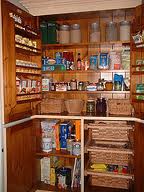 We have always heard that a person can live without food for 30 days, but can not survive longer than 3 days without water. But for individuals who are dependent on solid foods, it would certainly be difficult for them to make it through and thrive during an emergency situation where food is limited.
We have always heard that a person can live without food for 30 days, but can not survive longer than 3 days without water. But for individuals who are dependent on solid foods, it would certainly be difficult for them to make it through and thrive during an emergency situation where food is limited.
Earthquakes, hurricanes, typhoons, tornadoes, drought, fire accidents, gas surges, flooding, electrical accidents, or bio-hazards, are some of the typical events and disasters that people consider in their preparedness. While many homes are making all the essential preparations like: emergency strategies, bug-out kits, fire drills in case these occasions happen, you might not consider some unlikely disaster scenarios such as monetary crisis, State or Nation-wide electrical power interruption or worse – a severe food shortage.
This is why it is extremely important to consider some food storage guidelines to emergency preparedness. Part of this food storage guide to emergency preparedness is to recognize which sort of food can be utilized for emergency situations. We’ve shared often about the storage of whole wheat and other whole grains, but we want to expand beyond that in this short guide.
Canned products are the usual materials that many people determine to store as part of their preparation planning. Canned meat or bottled pickles are really common. Of course, you can also keep soups, vegetables and fruits for emergency cases. You will learn in this short food overview of emergency preparedness which veggie, fruit or soup is most effectively to store.
For veggies, a canned vegetable soup can be a good choice. Canned veggies, even processed, are still a reasonable source of vitamins and fiber, which you will definitely need. Throughout times of emergency, you do not want to be eating canned meat or high-sodium MRE’s all the time. Your body or mind will not function properly, so to maintain a good preparedness plan for your food storage, make certain your food intake consists of veggies and fruits. Having canned veggie soup on hand will help. Alternately, you might opt for jam-packed dried vegetables which are available in bulk. You can also make your very own dried vegetable foods. You can make use of food dehydrator to squeeze out liquids in veggies. Drying-out veggies will help extend their storage life.
Baby carrots are the most convenient to dehydrate. Once they are dried, they can be saved in mason containers. Baby carrots taste pretty good when dehydrated. To be able to eat the dried carrot, just add cold water and you’re prepared for a veggie meal. Another important part of this short food guide to emergency preparedness is the storage of canned soups. Pick canned soups that are fat free and rich in protein. Lentils are great examples of this. Lentil soups are also ready-to-eat.
Fruits in your food storage can be canned pineapple, papayas or peaches. Try to store fruits that you and your family prefer to eat. Of course, the first priority is to store foods that are easier to store and have a longer storage life. In an emergency situation, the last thing you will want is to find that your food has spoiled.
Canned meat is still a top choice for many people. You may want to have an inventory sheet with dates for your foods, and implement an organized rotation system to help you manage your storage foods. You may want to regularly consume foods from your storage, and with fresh. That will keep your storage foods and extend the life of your preparedness supplies. You will want to always consume your older food storage first. As a general guide to your emergency preparedness with your food storage, store just what you will consume and eat everything that you store.
There are a lot of helpful tips and training on food storage in the latest publication of PREPARE Magazine. Get a free subscription to PREPARE Magazine by going to: www.preparemag.com/subscribe
Related Content
Auto Amazon Links: No products found.




